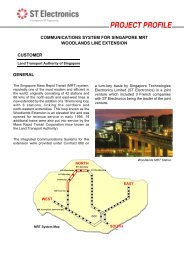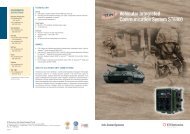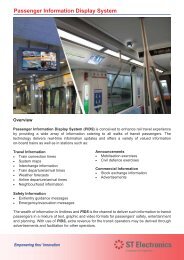The complete issue [ 36 pages | 2.38MB ] - ST Electronics
The complete issue [ 36 pages | 2.38MB ] - ST Electronics
The complete issue [ 36 pages | 2.38MB ] - ST Electronics
Create successful ePaper yourself
Turn your PDF publications into a flip-book with our unique Google optimized e-Paper software.
P R O D U C T S & S E R V I C E SDistributed aperture systemBy Andy Tan, Chief, System Engineering, <strong>ST</strong>ELOPAll round surveillance systems havetypically been achieved by connectingmultiple cameras or sensors todisplay monitors, with separate ormultiplexed views for each cameravideo stream. This approach poses achallenge to the operator, particularlyin a dynamic, realtime scenario ormoving platform environment.An operator has to monitor multipleviews to interpret large volumes ofimagery and look for potential targetsof interest. <strong>The</strong> overlap of informationfrom cameras also often causesdifficulty in target reporting leadingto unnecessary delays to the entiredetection process. Most of today’ssystems rely solely on the operator fordetection of an ‘event’.Further, this approach also presentschallenges to Human FactorEngineering (HFE) considerations.Figure 1 – All-round surveillance<strong>The</strong> presentation of large volumes ofvideo imagery coupled with the effectsof operational stress and fatiguesignificantly reduces the operator’seffectiveness.Distributed Aperture System<strong>ST</strong>ELOP’s Distributed Aperture System(DAS) provides solutions to the above<strong>issue</strong>s and enhances the performanceof surveillance assets and theiroperators. <strong>The</strong> product offers apreviously unattainable level of localsituational awareness to platformssuch as armoured vehicles operatingin closed hatch scenarios. <strong>The</strong> systemis also capable of providing videoimagery information to drivers havingto navigate difficult corners on urbanroads.Features of DAS• Provides instantaneous accessto <strong>36</strong>0-degree high resolutionrealtime panoramic videoimagery without camera rotationmechanism (no blind spots);• Easily integrates with an existingplatform’s cameras or sensors asit operates from a wide range ofdifferent physical sensor positionsand orientations;• Operator-friendly and intuitiveuser interface with the videopanorama display;• Video panorama can be pannedor zoomed instantaneouslyvia joystick and touch screeninterfaces notwithstandingcamera movements or thepanning and tilting of the system;• Panoramic display preservesintuitive spatial relationships;• Automatic moving target detectionof video stream over the <strong>36</strong>0degree field of view with realtimevisual and audio alerts;• Requires only single displaydevice for multiple input streams,thus saving space and power forthe platform;• Videos are aligned and presentedwithout distortion, such thatstraight lines in the real worldappear straight on the final imagedisplay;• Operates with cameras orsensors sensitive to any availablewaveband, thus reducing the needfor existing platform modification;Figure 2 - Zoomed-out panoramic viewFigure 3 - Zoomed-in panoramic view• Can be integrated with anindependent high resolutionsteer-able sensor, eg. gunner orcommander sighting system;• Provides driving and orientationsupport to the driver;• Outputs dual video streamthat allows both operators(eg. vehicle commander andtroop commander) to observethe vehicle’s surroundingssimultaneously;• Provides indications of platform’sposition relative to the omnidirectionalscene.<strong>The</strong> above features of DAS aredivided into two image-processingfunctionalities: ‘Data Extraction’ (thedetection of events) and ‘Visualisation’(the presentation of the multiple videoimages and information).26 ELECTRONICS REVIEW


![The complete issue [ 36 pages | 2.38MB ] - ST Electronics](https://img.yumpu.com/41667250/25/500x640/the-complete-issue-36-pages-238mb-st-electronics.jpg)
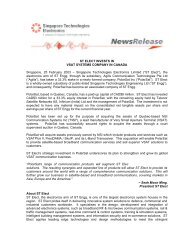
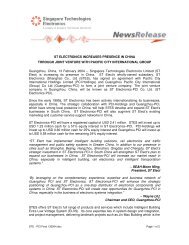


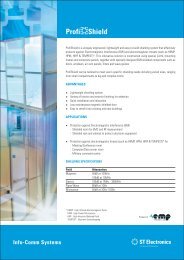


![The complete issue [ 32 pages | 2.43 MB ] - ST Electronics](https://img.yumpu.com/47270333/1/184x260/the-complete-issue-32-pages-243-mb-st-electronics.jpg?quality=85)



